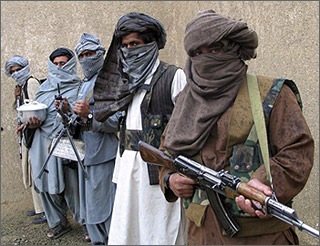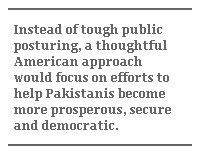Pakistan at the Crossroads – Part I
Pakistan at the Crossroads – Part I

WASHINGTON: Recent US intelligence warnings that Al Qaeda is reorganizing in Pakistan – along with the recent debate among presidential candidates over whether the US should be prepared to take action there – underscore a reality that has until recently been overlooked: The key to the war on terror lies not in Afghanistan, but next door in Pakistan.
Al Qaeda is reorganizing in Pakistan. Osama bin Laden, Ayman al-Zawahiri and other leaders hide in Pakistan. British and other extremists obtain terrorist training and financing in Pakistan, and the US has caught a majority of “high-value detainees” in Pakistan.
Pakistan also serves as a refuge, financial center and training ground for Taliban fighters who seek to destabilize Afghanistan.

Recognition of this reality is not to suggest that the US and NATO ought to contemplate a military mission on the Pakistani side of the border. Recently when I traveled around northwestern Pakistan, people were buzzing about former US Central Command General John Abizaid’s comment that a crisis in Pakistan would make Afghanistan and Iraq “look easy,” wrongly suspecting that he was hinting at the possible need for military force.
Military intervention in Pakistan, however, would be a recipe for disaster even if NATO had the 200,000 troops needed to do it on the scale of the Afghanistan mission – which it does not. Even covert actions or targeted strikes on “actionable targets,” which the Bush administration has not ruled out, could backfire. Obviously if the US obtains hard and specific evidence of the Al Qaeda leadership’s presence in Pakistan, it must act, preferably in cooperation with the government of Pakistan. But the Al Qaeda presence in northwest Pakistan is dispersed across a vast, mountainous region, and US military actions there could turn fiercely nationalistic Pakistanis even further against the US without any certainty of hitting targets.

The problems in Pakistan may not have a military solution, but there is no use pretending that the US has the luxury of focusing only on the Afghan side of the border. Pakistani President Pervez Musharraf is in many ways a US ally who has provided valuable cooperation in the war on terror. But while he cooperates with the US by sending troops to hunt Al Qaeda in the mountains, other branches of the Pakistani security establishment – keen to protect their Pashtun brethren and fearful of Indian influence in Afghanistan – actively support the Taliban. This leaves the US in an absurd situation: The US gives Pakistan around $1 billion per year, mostly in military aid, some of which finds its way to the Taliban fighters that the rest is designed to fight.
Much of the discussion in Washington focuses on “pressuring” Musharraf. The Bush administration is already doing it and not getting far. Indeed, excessive public pressure could backfire, making any Pakistani cooperation against Al Qaeda and the Taliban appear to be the action of an American stooge.
Instead of tough public posturing, a more thoughtful American approach would focus on efforts to help Pakistanis become more prosperous, secure and democratic – therefore less likely to support extremism in the first place. A first step in such an approach would be for Washington to complement military aid to Pakistan with more economic and humanitarian assistance. Pakistanis resent the fact that most American dollars end up in the hands of the military and security services, and in the long run, better opportunities for the country’s people would eliminate extremism. Greater Western openness to imports from Pakistan, financial support for its failing public education system and job-creating development assistance would do more to wean Pakistan’s large youth population away from extremism than any amount of diplomatic pressure or the threat of military force.

The US must also support a transition to democratic rule. Tolerating Musharraf’s ongoing military dictatorship would be a debatable proposition if the US were getting impeccable cooperation on terrorism, but is less compelling when that cooperation is halfhearted. Indeed it is ironic that President Bush – who so forcefully argued that US support for dictators in the Muslim world is the primary cause for extremism there – fails to see that dynamic taking place today.
In a range of discussions with Pakistani students, journalists, politicians and policy experts, I found almost no one willing to support the increasingly authoritarian general and much anger directed at the US for backing him. The last few months in Pakistan have seen the abrupt removal of the Supreme Court chief justice and his subsequent reinstatement, the killing of some 40 protesters in Karachi, the murder of another Supreme Court official, an aborted attempt to stifle independent television stations and a general strike – precisely the string of explosive events that Bush argues produce “stagnation, resentment, and violence ready for export,” that his democracy-promotion doctrine was supposedly designed to avoid.
Some fear that democratically elected leaders in Pakistan would be less ready to support the US. That fear is not entirely misplaced, but it understates the leverage Washington would have over those leaders and overlooks the fact that their actions would have more legitimacy in Pakistani eyes than anything done by the current regime. It also misses the point that, in the long run, repression will create more terrorists than the government could ever arrest or kill. Islamist parties in Pakistan have never done well in free elections, and they would not win if such elections were held today. But if Musharraf ends up clinging to power through repression rather than elections, support for Islamic extremism, as the only alternative, could rise.

If we really want to address a major source of extremism emanating from Pakistan, the US should use the current period of relative calm between Pakistan and India – and the leverage derived from its growing partnership with India – to launch a new diplomatic effort on the disputed region of Kashmir. A deal – in which the current “line of control” in Kashmir becomes a recognized border between India and Pakistan and the Muslim areas of Kashmir constitute a special zone within India – could form the basis for peace between the two nuclear neighbors. The proposed deal could provide for significant autonomy within both the Indian- and Pakistani-controlled parts of Kashmir, the creation of a consultative group that would include Kashmiris, Pakistanis, Indians and perhaps others, as well as the gradual demilitarization of the region. Such a step toward peace – supported diplomatically and financially by the international community – would make it possible for Musharraf to shut down the many Pakistani extremist groups for which Kashmir is the raison d’être, and further undermine the perceived Pakistani need for a Taliban client in Afghanistan. It would also facilitate badly needed economic and energy cooperation from Pakistan, India and Afghanistan.
So by all means, the US must continue to focus on Afghanistan and devote the resources necessary to succeed there. But the US cannot neglect Pakistan, which is ultimately the greater potential problem. Helping it overcome its vast domestic challenges, and giving Pakistanis a more hopeful future, would do more for the war on terror than any number of new troops next door.
Philip H. Gordon is senior fellow for US Foreign Policy at the Brookings Institution. His latest book, “Winning the Right War: The Path to Security for America and the World,” will be released August 21.